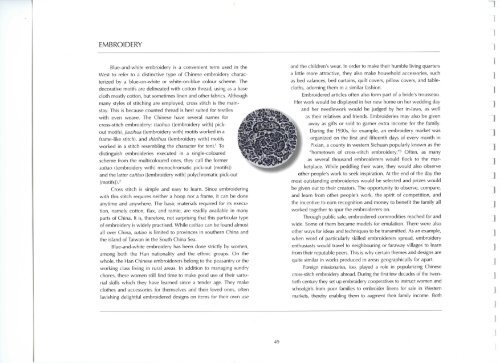Touched by Indigo - Royal Ontario Museum
Touched by Indigo - Royal Ontario Museum
Touched by Indigo - Royal Ontario Museum
Create successful ePaper yourself
Turn your PDF publications into a flip-book with our unique Google optimized e-Paper software.
!<br />
EMBROIDERY<br />
Blue-and-white embroidery is a convenient term used in the<br />
West to refer to a distinctive type of Chinese embroidery characterized<br />
<strong>by</strong> a blue-on-white or white-on-blue colour scheme. The<br />
decorative motifs are delineated with cotton thread, using as a base<br />
cloth mostly cotton, but sometimes linen and other fabrics. Although<br />
many styles of stitching are employed, cross stitch is the mainstay.<br />
This is because counted thread is best suited for textiles<br />
with even weave. The Chinese have several names for<br />
cross-stitch embroidery: tiaohua ([embroidery with] pickout<br />
motifs), jiazihua ([embroidery with] motifs worked in a<br />
frame-like stitch), and shizihua ([embroidery with] motifs<br />
worked in a stitch resembling the character for ten).1 To<br />
distinguish embroideries executed in a single-coloured<br />
scheme from the multicoloured ones, they call the former<br />
sutiao ([embroidery with] monochromatic pick-out [motifs])<br />
and the latter caitiao ([embroidery with] polychromatic pick-out<br />
[motifs]).2<br />
Cross stitch is simple and easy to learn. Since embroidering<br />
with this stitch requires neither a hoop nor a frame, it can be done<br />
anytime and anywhere. The basic materials required for its execution,<br />
namely cotton, flax, and ramie, are readily available in many<br />
parts of China. It is, therefore, not surprising that this particular type<br />
of embroidery is widely practised. While caitiao can be found almost<br />
all over China, sutiao is limited to provinces in southern China and<br />
the island of Taiwan in the South China Sea.<br />
Blue-and-white embroidery has been done strictly <strong>by</strong> women,<br />
among both the Han nationality and the ethnic groups. On the<br />
whole, the Han Chinese embroiderers belong to the peasantry or the<br />
working class living in rural areas. In addition to managing sundry<br />
chores, these women still find time to make good use of their sartorial<br />
skills which they have learned since a tender age. They make<br />
clothes and accessories for themselves and their loved ones, often<br />
lavishing delightful embroidered designs on items for their own use<br />
:<br />
and the children's wear. In order to make their humble living quarters<br />
a little more attractive, they also make household accessories, such<br />
as bed valances, bed curtains, quilt covers, pillow covers, and tablecloths,<br />
adorning them in a similar fashion.<br />
Embroidered articles often also form part of a bride's trousseau.<br />
Her work would be displayed in her new home on her wedding day<br />
and her needlework would be judged <strong>by</strong> her in-laws, as well<br />
as their relatives and friends. Embroideries may also be given<br />
away as gifts or sold to garner extra income for the family.<br />
During the 1930s, for example, an embroidery market was<br />
organized on the first and fifteenth days of every month in<br />
Pixian, a county in western Sichuan popularly known as the<br />
"hometown of cross-stitch embroidery."3 Often, as many<br />
as several thousand embroiderers would flock to the marketplace.<br />
While peddling their ware, they would also observe<br />
other people's work to seek inspiration. At the end of the day the<br />
most outstanding embroideries would be selected and prizes would<br />
be given out to their creators. The opportunity to observe, compare,<br />
and learn from other people's work, the spirit of competition, and<br />
the incentive to earn recognition and money to benefit the family all<br />
worked together to spur the embroiderers on.<br />
Through public sale, embroidered commodities reached far and<br />
wide. Some of them became models for emulation. There were also<br />
other ways for ideas and techniques to be transmitted. As an example,<br />
when word of particularly skilled embroiderers spread, embroidery<br />
enthusiasts would travel to neighbouring or faraway villages to learn<br />
from their reputable peers. This is why certain themes and designs are<br />
quite similar in works produced in areas geographically far apart.<br />
Foreign missionaries, too, played a role in popularizing Chinese<br />
cross-stitch embroidery abroad. During the first few decades of the twentieth<br />
century they set up embroidery cooperatives to instruct women and<br />
schoolgirls from poor families to embroider linens for sale in Western<br />
markets, there<strong>by</strong> enabling them to augment their family income. Both<br />
49
















